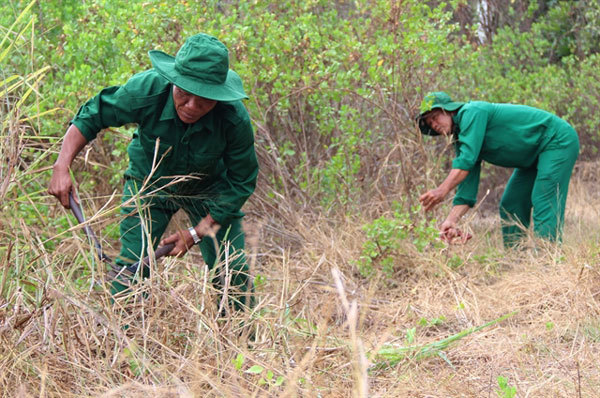Can Gio Mangrove biosphere reserve
Exploring Vam Sat ecological tourist site in Can Gio
 |
| Two forest watchers at the Can Gio Mangrove Forest cutting down dry bushes to prevent forest fire. VNA Photo |
They patrol the swamp land to look out for illegal loggers, poachers and early detection of forest fires.
Despite having UNESCO status since 2000, local rangers struggle to monitor the whole area which covers 35,000 hectares.
The watchers live, sleep and eat among the mangrove for as long as they can, in order to ease the burden on the rangers who work there.
Without fresh water, little cell phone coverage and hardly any electricity, families of helpers hope to help protect the biosphere reserve.
The watchers are in charge of monitoring more than 7.500ha of the 35.000 hectare forest. Checkpoints in the middle of nowhere were turned into homes and living quarters.
Any electrical equipment they use generates power from just a few solar panels.
But despite the tough living conditions, the people say they are doing it for the greater good. Some have even been living in the forest for many years.
“My wife and I registered our names as forest watchers back in 2013,” said forest watcher Vo Minh Tam.
“We grew up around here. When I was a kid I used to go fishing in the forest. I love the forest. That’s why I signed up”.
When he first told his families of the idea they tried to stop him. His in-laws also disliked the idea of him bringing his wife to live in the forest. They offered them land but the couple refused.
Tam and his wife now patrol the forest as oppose to making a living from fishing and raising poultry like they did in the past.
“My families eventually changed their mind,” Tam said, ”At first, they only came to see how we were doing but now they quite like it here. They have visited often and brought us supplies.”
Another watcher Truong Thi Quy had to send her kids to live with their grandparents so they could go to school.
“I grew up in a town nearby and I love the forest. My parents were forest watchers and I took it up after they retired,” Quy said.
“Our friends told us we could get jobs elsewhere that pay better but who will protect the forest if we all go?” she said.
Loggers and poachers could turn violent when they are caught so watchers are told to always stay in touch with local authorities.
Watchers’ biggest fear, however, was forest fires. The mangrove is susceptible to fire, especially during the dry season. The protection of its flora, many are oil plants, require the watchers to be constantly on the move to cover their designated areas.
Thanks to the watchers. The number of illegal loggings and poaching incidents has declined in recent years. Local authorities and the forest’s management unit are working together to provide them with more equipment and training and to raise awareness among local community to help support the watchers in their mission.
VNS
 More than a hundred forest watchers from the HCM City’s Youth Volunteers are spending their days and nights in the vast Can Gio Mangrove Forest." itemprop="description" />
More than a hundred forest watchers from the HCM City’s Youth Volunteers are spending their days and nights in the vast Can Gio Mangrove Forest." itemprop="description" />